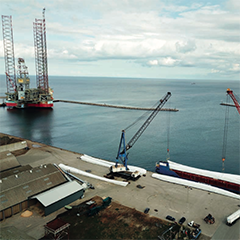The Port of Grenaa has grown from a small fishing port to an international hub, with the capacity and know-how to serve the offshore wind market. The pre-assembly facilities, the ease of access and experience, makes it the ideal port to access Denmark, Sweden and Northern Europe. Theis Gisselbæk, the CCO, gives PES an insight into its growth.
PES: Welcome to PES Wind magazine, it’s great to talk with you. It would be great if you could give us some background on the Port of Grenaa.
Theis Gisselbæk: The Port of Grenaa has a long history, and it celebrated its 200th anniversary in 2013 at the same time as the installation of the Anholt offshore wind farm. In the early beginnings Port of Grenaa was primarily a fishing and ferry port. Over the years the port has broadened its work to especially bulk activities.
Our latest big port expansion was inaugurated in 2010. The planning of this development process started at the end of the 90-ties.
The wind industry has always been a natural part of our portfolio. Nordtank, a local company, is now, after several mergers, part of the Vestas group. The Port of Grenaa also has a long tradition in handling onshore wind components. In 2010 we had a breakthrough in the offshore market with the installation of Anholt offshore wind farm, which was the largest offshore wind farm in Denmark at that time.
PES: We know the offshore market is expanding, how is this impacting on your business?
TG: We follow the developments in the offshore wind industry closely. It is an intriguing development currently with the planning of new offshore wind farms in the Kattegat, off the Danish east coast and at the Swedish west coast. More specifically we continuously keep up with the industry and plan for ongoing investments at the port, to make sure our setup is always attractive and up to date.














